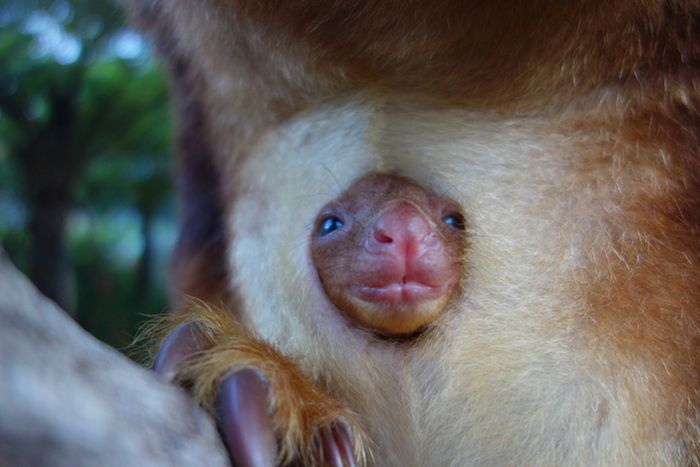|
|
Baby Tree Kangaroo Joey, Taronga Zoo, Sydney, New South Wales, Australia
|
They inhabit the tropical rainforests of New Guinea and far northeastern Queensland, and some of the islands in the region — in particular the Schouten Islands and the Raja Ampat Islands near the northwestern coast of New Guinea. Although most are found in mountainous areas, several species also occur in lowlands, such as the aptly named lowlands tree-kangaroo. Most tree-kangaroos are considered threatened due to hunting and habitat destruction. Because most of their motion and living involves climbing and jumping from tree to tree, they developed better locomotion. Tree kangaroos thrive in tree tops as opposed to their cousin the kangaroo which survives on mainland in Australia. Two species of kangaroo are found in Australia, Bennett's (Dendrolagus bennetianus) which is found north of the Daintree River and Lumholtz's (Dendrolagus lumholtzi). Tree kangaroos have adapted better to regions of high altitudes. Tree kangaroos have at least fifteen known subspecies living in Papua New Guinea and Australia. Tree kangaroos must find places comfortable and well adapted for breeding as they only give birth to one joey per year. They are known to have one of the most relaxed and leisurely birthing seasons. They breed cautiously in treetops during monsoon season. Their habitats are breeding grounds for danger as they can easily fall prey to their natural predator, amethystine pythons, which also climbs and lives amongst the treetops in the forests. Tree kangaroos are known to be able to live in both mountainous regions and low-land locations.
Evolution
The evolutionary history of tree-kangaroos begins with a rainforest floor dwelling pademelon-like ancestor (Thylogale spp.). This ancestor evolved from an arboreal possum-like ancestor as is suspected of all macropodid marsupials in Australia and New Guinea. During the late Eocene the Australian/New Guinean continent began a period of drying that caused a retreat in the area of rainforest. The retreat of the rainforest forced the ancestral pademelons to begin living in a dryer, rockier environment. After some generations of adaptation to the new environment, the pademelons evolved into rock-wallabies (Petrogale spp.). The rock-wallabies developed a generalist feeding strategy due to their dependence on a diverse assortment of vegetation refuges. This generalist strategy allowed the rock-wallabies to easily adapt to malesian rainforest types that were introduced to Australia from Asia during the mid-Miocene. The rock-wallabies that migrated into these introduced forests adapted to spend more time climbing trees. One species in particular, the proserpine rock-wallaby (Petrogale persephone), displays equal preference for climbing trees as for living in rocky outcrops. During the late-Miocene the semi-arboreal rock-wallabies evolved into the now extinct tree-kangaroo genus Bohra. Global cooling during the Pleistocene caused continent wide drying and rainforest retractions in Australia and New Guinea. The rainforest contractions isolated populations of Bohra which resulted in the evolution of today's tree-kangaroos (Dendrolagus spp.) as they adapted to lifestyles in geographically small and diverse rainforest fragments, and became further specialized for a canopy dwelling lifestyle.
|
|









